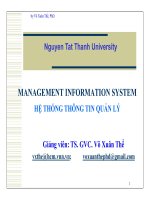Management information system ralp 7e ch09
Bạn đang xem bản rút gọn của tài liệu. Xem và tải ngay bản đầy đủ của tài liệu tại đây (921 KB, 48 trang )
• An organization’s TPS must support the routine, day-today activities that occur in the normal course of business
and help a company add value to its products and services
• Identify the basic activities and business objectives
common to all transaction processing systems
• Explain some key control and management issues
associated with transaction processing systems
• Describe the inputs, processing, and outputs for the
transaction processing systems associated with order
processing, purchasing, and accounting business processes
Principles of Information Systems, Seventh Edition
2
• TPSs help multinational corporations form business links
with their business partners, customers, and subsidiaries
• Identify the challenges that multinational corporations must
face in planning, building, and operating their TPSs
Principles of Information Systems, Seventh Edition
3
• Implementation of an enterprise resource planning system
enables a company to achieve numerous business benefits
through the creation of a highly integrated set of systems
• Discuss the advantages and disadvantages associated with
the implementation of an enterprise resource planning
system
Principles of Information Systems, Seventh Edition
4
An Overview of Transaction Processing
Systems
• A transaction processing system (TPS) provides data for
other business processes
• Management information system/decision support system
(MIS/DSS)
• Special-purpose information systems
Principles of Information Systems, Seventh Edition
5
Figure 9.1: TPS, MIS/DSS, and Special
Information Systems in Perspective
Principles of Information Systems, Seventh Edition
6
An Overview of Transaction Processing
Systems (continued)
• TPSs
• Process the detailed data necessary to update records about
the fundamental business operations
• Include order entry, inventory control, payroll, accounts
payable, accounts receivable, the general ledger, and more
Principles of Information Systems, Seventh Edition
7
Traditional Transaction Processing
Methods and Objectives
• Batch processing system: method of computerized
processing in which business transactions are
accumulated over a period of time and prepared for
processing as a single unit or batch
• Online transaction processing (OLTP): computerized
processing in which each transaction is processed
immediately, without the delay of accumulating
transactions into a batch
Principles of Information Systems, Seventh Edition
8
Figure 9.2: Batch Versus Online
Transaction Processing
Principles of Information Systems, Seventh Edition
9
Traditional Transaction Processing
Methods and Objectives (continued)
• Online entry with delayed processing: transactions are
entered into the computer system when they occur, but
they are not processed immediately
• Organizations expect their TPSs to:
• Process data generated for and about transactions
• Maintain a high degree of accuracy and integrity
• Produce timely documents and reports
Principles of Information Systems, Seventh Edition
10
Traditional Transaction Processing
Methods and Objectives (continued)
• Organizations expect their TPSs to (continued):
• Increase labor efficiency
• Help provide increased service
• Help build and maintain customer loyalty
• Achieve competitive advantage
Principles of Information Systems, Seventh Edition
11
Figure 9.3: Integration of a Firm’s TPSs
Principles of Information Systems, Seventh Edition
12
Transaction Processing Activities
• TPSs
• Capture and process data that describes fundamental
business transactions
• Update databases
• Produce a variety of reports
• Transaction processing cycle: the process of data
collection, data editing, data correction, data
manipulation, data storage, and document production
Principles of Information Systems, Seventh Edition
13
Figure 9.4: A Simplified Overview of a
Transaction Processing System
Principles of Information Systems, Seventh Edition
14
Figure 9.5: Data Processing Activities
Common to TPSs
Principles of Information Systems, Seventh Edition
15
Transaction Processing Activities
(continued)
• Data collection
• Should be collected at source
• Should be recorded accurately, in a timely fashion
• Data editing
• Data correction
Principles of Information Systems, Seventh Edition
16
Transaction Processing Activities
(continued)
• Data manipulation
• Data storage
• Document production and reports
Principles of Information Systems, Seventh Edition
17
Control and Management Issues
• Business continuity planning: identification of the
business processes that must be restored first in the event
of a disaster and specification of what actions should be
taken and who should take them to restore operations
• Disaster recovery: actions that must be taken to restore
computer operations and services in event of disaster
Principles of Information Systems, Seventh Edition
18
Transaction Processing System Audit
• Does the system meet the business need for which it was
implemented?
• What procedures and controls have been established?
• Are these procedures and controls being used properly?
• Are the information systems and procedures producing
accurate and honest reports?
Principles of Information Systems, Seventh Edition
19
Table 9.2: The Systems That Support
Order Processing, Purchasing, and
Accounting Functions
Principles of Information Systems, Seventh Edition
20
Order Processing Systems
• Order entry
• Sales configuration
• Shipment planning
• Shipment execution
Principles of Information Systems, Seventh Edition
21
Order Processing Systems (continued)
• Inventory control
• Invoicing
• Customer relationship management
• Routing and scheduling
Principles of Information Systems, Seventh Edition
22
Figure 9.7: Order Processing Systems
Principles of Information Systems, Seventh Edition
23
Order Processing Systems (continued)
• Order entry system: captures the basic data needed to
process a customer order
• Sales configuration system: ensures that the products
and services ordered are sufficient to accomplish the
customer’s objectives and will work well together
• Shipment planning system: determines which open
orders will be filled and from which location they will
be shipped
Principles of Information Systems, Seventh Edition
24
Figure 9.8: Data Flow Diagram of an Order
Entry System
Principles of Information Systems, Seventh Edition
25









